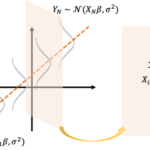コメント
二項分布の条件付き確率を題材にした問題でした。問3, 5の計算が若干煩雑ですが素直に解ける問題が並んでおり、統計検定1級としては簡単な問題です。
この大問の難易度を見極めて時間をかけられたかがポイントになったと思います。
問題
(出典:統計検定HP「統計検定 1級の過去問題」。問題文を一部略記。)
問1
確率[math]\theta[/math]のベルヌーイ分布に従う[math]n[/math]個の互いに独立な確率変数を[math]X_i[/math]とする。この時、[math]X=\sum_{i=1}^n X_i[/math]が成立し、ベルヌーイ分布の期待値と分散は[math]E[X_i] = \theta[/math], [math]V[X_i]=\theta(1-\theta)[/math]なので
[math]
\begin{eqnarray}
E[X] &=& \sum_{i=1}^n E[X_i] = n\theta
\\
V[X] &=& \sum_{i=1}^n V[X_i] = n\theta(1-\theta)
\end{eqnarray}
[/math]
である。
問2
[math]
h(x)=\dfrac{_n C_{x} \theta^{x}(1-\theta)^{n-x}}{1-(1-\theta)^{n}} \quad(x=1, \dots, n)
[/math]
条件付き確率を求めると
[math]
\begin{eqnarray}
h(x) &=& P(X=x|X\geq 1) \\
&=& \dfrac{P(X=x, X \geq 1)}{P(X \geq 1)} \\
&=& \dfrac{P(X=x, X \geq 1)}{1 – P(X = 0)} \\
&=& \dfrac{{}_nC_x \theta^{x}(1-\theta)^{n-x}}{1-(1-\theta)^{n}},\ x=1,2,\dots,n
\end{eqnarray}
[/math]
である。
問3
まず[math]\eta(\theta)[/math]を求めると
[math]
\begin{eqnarray}
\eta(\theta) &=& E[X | X \geq 1] \\
&=& \sum_{k=1}^n k P(X=k|X\geq 1) \\
&=& \dfrac{1}{1-(1-\theta)^{n}}\sum_{k=1}^n k {}_nC_k \theta^{k}(1-\theta)^{n-k} \\
&=& \dfrac{1}{1-(1-\theta)^{n}}E[X] \\
&=& \dfrac{n\theta}{1-(1-\theta)^{n}}
\end{eqnarray}
[/math]
である。
次に[math]\xi(\theta)[/math]を求める。
[math]
\begin{eqnarray}
\xi(\theta) &=& V[X | X \geq 1] \\
&=& E[X^2 | X \geq 1] – E[X | X \geq 1]^2
\end{eqnarray}
[/math]
より[math]E[X^2 | X \geq 1][/math]を求めると[math]E[X | X \geq 1][/math]と同様に
[math]
\begin{eqnarray}
&&
E[X^2 | X \geq 1] \\
&=& \dfrac{1}{1-(1-\theta)^{n}}E[X^2] \\
&=& \dfrac{1}{1-(1-\theta)^{n}}(V[X] + E[X]^2) \\
&=& \dfrac{n\theta(1-\theta)+n^2\theta^2}{1-(1-\theta)^{n}}
\end{eqnarray}
[/math]
なので
[math]
\begin{eqnarray}
&&
\xi(\theta) \\
&=& \dfrac{n\theta(1-\theta)+n^2\theta^2}{1-(1-\theta)^{n}} – \dfrac{n^2\theta^2}{\left(1-(1-\theta)^{n}\right)^2} \\
&=& \dfrac{n\theta(1-\theta)}{1-(1-\theta)^{n}} – \dfrac{n^2\theta^2(1-\theta)^{n}}{\left(1-(1-\theta)^{n}\right)^2}
\end{eqnarray}
[/math]
である。
問4
[math]n=8[/math]の時、
[math]
\begin{eqnarray}
&& \eta(\theta)=2 E[X] \\
&\Leftrightarrow& \dfrac{8 \theta}{1-(1-\theta)^{8}}=2\cdot 8 \cdot \theta \\
&\Leftrightarrow& (1-\theta)^{8}=\dfrac{1}{2} \\
&\Leftrightarrow& \theta = 1 – \dfrac{1}{\sqrt[8]{2}}
\end{eqnarray}
[/math]
である。
問5
対数尤度関数の微分を考えると
[math]
\begin{eqnarray}
&& \dfrac{d}{d \theta} \log L(\theta) \\
&=& \sum_{i=1}^m
\dfrac{d}{d \theta} \log h(\theta; y_i) \\
&=& \sum_{i=1}^m \left( \dfrac{y_{i}}{\theta}-\dfrac{n-y_{i}}{1-\theta}-\dfrac{n(1-\theta)^{n-1}}{1-(1-\theta)^{n}} \right) \\
&=& \dfrac{m\bar{y}}{\theta}-\dfrac{m(n-\bar{y})}{1-\theta}-\dfrac{mn(1-\theta)^{n-1}}{1-(1-\theta)^{n}}
\end{eqnarray}
[/math]
なので尤度方程式は
[math]
\begin{eqnarray}
&&
\dfrac{d}{d \theta} \log L(\theta)=0 \\
&\Leftrightarrow& \dfrac{m\bar{y}}{\theta}-\dfrac{m(n-\bar{y})}{1-\theta}-\dfrac{mn(1-\theta)^{n-1}}{1-(1-\theta)^{n}} = 0 \\
&\Leftrightarrow& \bar{y}(1-\theta) – \theta(n-\bar{y})-\dfrac{n\theta(1-\theta)^{n}}{1-(1-\theta)^{n}} = 0 \\
&\Leftrightarrow& \bar{y} = n \theta\left\{1+\dfrac{(1-\theta)^{n}}{1-(1-\theta)^{n}}\right\} \\
&\Leftrightarrow& \bar{y} = \dfrac{n\theta}{1-(1-\theta)^{n}}
\end{eqnarray}
[/math]
とかける。この式は尤度方程式の解である最尤推定値について条件付き期待値が標本平均と一致することを示しており最尤推定値はモーメント法の解にもなっている。
最尤推定値の計算方法は尤度方程式が[math]
\theta = \frac{\bar{y}\left\{1-(1-\theta)^{n}\right\}}{n}[/math]とかけることから
初期値[math]\theta^{(0)}[/math]を適当に決め
[math]
\theta^{(k+1)} = \dfrac{\bar{y}\left\{1-(1-\theta^{(k)})^{n}\right\}}{n}
[/math]
を反復することで得られる。
シリーズ記事
- 過去問と解答例
- 2018年(統計数理)大問2
- 2018年(統計数理)大問2 解答例
- 2018年(統計数理)大問3
- 2018年(統計数理)大問3 解答例(本記事)
- 2018年(統計数理)大問5
- 2018年(統計数理)大問5 解答例




